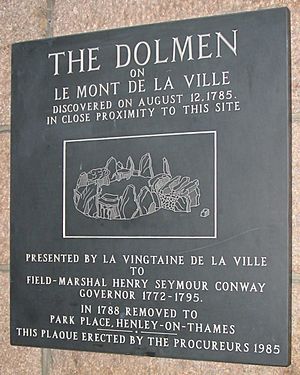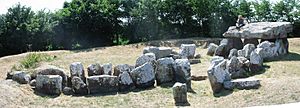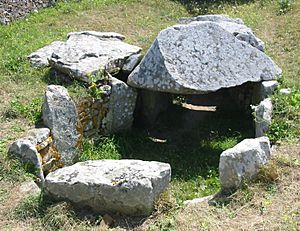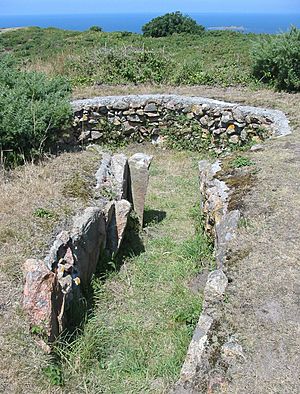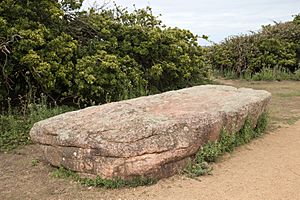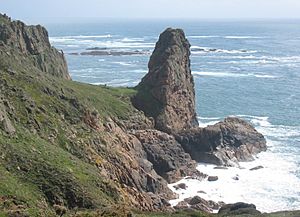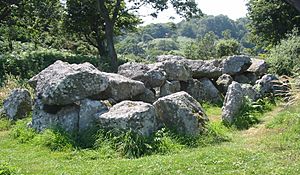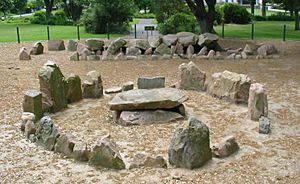Jersey dolmens facts for kids
The dolmens of Jersey are ancient stone structures found on the island of Jersey. These amazing sites were built a very long time ago, between about 4800 BC and 2250 BC. This time is known as the Neolithic period, or "New Stone Age," and also the Chalcolithic period, or "Copper Age."
Before these dolmens were built, people lived in Jersey during the Paleolithic or "Old Stone Age." One famous site, La Cotte de St Brelade, shows that both Neanderthals and early humans lived there. These early people were hunter-gatherers, meaning they moved around to find food. At La Cotte, we know they even hunted woolly mammoths!
Contents
Discovering Jersey's Dolmens
By the time the dolmens were built, people had settled down in Jersey. Back then, Jersey was still connected to Europe by a land bridge, which disappeared around 6800 BC. The New Stone Age was different from the Old Stone Age because people started farming the land instead of just hunting. They still used stone tools like axes and daggers.
We don't have any traces of their homes. Experts think they likely lived in simple wooden huts sealed with mud and clay. These huts have long since disappeared. Only the strong stone structures like dolmens and menhirs remain today.
For a long time, people thought these Neolithic sites, like dolmens and passage graves, were mainly tombs for important leaders, like kings or chiefs. They imagined tribes working hard to build stone burial places, similar to how ancient Egyptians built pyramids for their pharaohs.
But modern archaeologists, like Mark Patton, have found that these dolmens don't seem to be used that way. The human remains found in them are very few. Sometimes, like at La Sergenté, no human bones are found at all. This is also true in Brittany, where animal bones are sometimes found instead of human bones. This suggests that these "passage graves" might not have been built just for burials.
In fact, many of these sites in Britain and Europe were opened and used again over time. One site even had five different ways of burying people, but for only ten individuals!
What Were Dolmens Used For?
So, if dolmens weren't just tombs, what were they for? Mark Patton suggests thinking of them like churches or cathedrals today. He explains that if you dug up Westminster Abbey, you'd find human bones because people are buried there. But Westminster Abbey isn't just a tomb; it's a religious center.
Historian Ronald Hutton agrees. He believes these sites were mainly used as religious centers. Each dolmen might have been a special place for a group of scattered farms or a settlement, like a family or clan. It was a bit like a very early "parish" or community gathering spot.
So, we can imagine ancient tribes coming together at these dolmens. They might have celebrated important times of the year with special ceremonies, marking the changing seasons. Some local stories even connect dolmens to fairies, called "pouques" in Jersey folklore.
Major Dolmen Sites in Jersey
Here are some of the main dolmen sites you can find in Jersey:
- La Hougue Bie
- La Pouquelaye de Faldouet
- Le Mont Ubé
- Le Couperon
- La Sergenté
- Les Monts de Grantez
- La Hougue des Géonnais
- Ville-ès-Nouaux
- The Broken Menhir
- The Ossuary
- The Little Menhir
- The Great Menhir
- La Table des Marthes
- Les Trois Rocques
- Le Pinacle
La Pouquelaye de Faldouet
This ancient passage grave is in the Parish of St Martin. It has a 5-meter long passage that leads into a large round room. Beyond that is another room with a big capstone (a large flat stone forming a roof). Smaller side rooms and cists (stone boxes) are around the main chamber. Archaeologists have found human bones from at least three people here, along with pottery, stone axes, and flint tools.
Les Monts de Grantez
This Neolithic passage grave is in the Parish of St Ouen. It has a nice passage chamber with one side room to the north. Both the passage and the side room still have their capstones. When it was dug up in 1912, archaeologists found the skeletons of eight people: seven adults and one child. Seven were lying on their sides, curled up, and one was sitting upright in the passage. Animal bones, pottery, shells, and pebbles were also found.
Mark Patton noted that how people were buried varied a lot. At Mont Grantez, seven full skeletons were found. But often, only scattered bones are found, which suggests bodies might have been exposed or buried elsewhere first.
La Sergenté
This unique passage grave is in the Parish of St Brelade. It has a round chamber with a short entrance passage. When it was first dug up in 1923, a lot of rubble was found inside. This rubble was probably from a fallen, bee-hive shaped roof. This type of roof is special to the Channel Islands.
The site is on open land with a clear view to La Table des Marthes. Mark Patton explained that this type of roof needed a rock that breaks into long, flat pieces. The rock available in Jersey wasn't suitable. So, even though La Sergenté is the oldest passage grave in Jersey, its roof collapsed soon after it was built. This design wasn't used again on the islands.
La Hougue des Géonnais
This is a Neolithic passage chamber in the parish of St Ouen. Much of it was damaged by quarrying (taking stone) before it was first dug up in 1929. Later digs (1985-1990) found a D-shaped chamber that was later made into a larger rectangular chamber. Many items were found, including pottery, flint scrapers, arrowheads, and broken querns (stones for grinding grain).
Mark Patton noted that some passage graves in Jersey, like La Hougue des Géonnais, have large, open chambers. These chambers couldn't have been covered by capstones because the upright stones were too small. A bee-hive shaped roof wouldn't work with the local stone. He suggests these chambers might have had wooden roofs, but no evidence was found. If they were open, the stone mound around them would have formed a platform around an open "arena."
La Table des Marthes
This is a large, flat granite slab at the western end of The Railway Walk. When it was looked at in 1850, it was supported by stone and earth pillars. Pottery, burnt stones, and broken stone axes were found. We don't know exactly what it was used for or what kind of structure it was part of.
Some people think it's a huge capstone from the late Neolithic or early Bronze Age (around 2500 to 3000 BC). In more recent times, people in Jersey used it as a place to sign important agreements. This might be why it was left standing next to the old St Helier to La Corbière railway, while many other sites were partly destroyed for building materials.
The name "La Table des Marthes" might mean "The Witnesses' Table." This name probably comes from the custom of signing important documents at this stone.
Le Pinacle
Le Pinacle is a natural rock formation that looks like a giant menhir. The ancient site is located below this imposing rock. The path down to the site is very dangerous, and it's not safe to go down without trained climbers.
Archaeologists have found two earth and rubble walls from the Neolithic/Chalcolithic periods and a third from the Bronze Age. Six pieces of iron found here show that people lived here during the Iron Age. In Roman times, there was a rectangular Gallo-Roman temple at the site. Many items have been found, including flints, hammers, polishing stones, a copper arrowhead, a bronze spearhead, pottery, and a Roman coin.
Mark Patton mentions that an axe-making center was found at Le Pinacle. Axes made from a type of stone called dolerite from Le Pinacle have been found in Guernsey, Sark, and Alderney, as well as Jersey. However, these axes don't seem to be found on the nearby mainland of Armorica (France).
La Hougue Boëte
This is a tall, oval mound in the Parish of St John. Inside, a four-sided Neolithic chamber was found when tunnels were dug in 1911. The stone box (cist) inside held an unusual burial: a man lying on top of a horse. Other finds included a round pot and a piece of a greenstone axe. The horse bones were dated to the Celtic period. It seems this site was built in Neolithic times and then reused by Celts for a chieftain's burial.
This is the only known large stone cist with a round mound of its kind in the Channel Islands. It might be connected to early Neolithic cists in southern Brittany. The site is also interesting because it was once the location of a local court.
Long ago, the Duke of Normandy gave land in Jersey to his favorite people. These people became "Seigneur" (lords) of a fief (an area of land). They often lived in a manor house in the center of their land. Anyone living on a fief paid rent to the church and worked for a certain number of days on the Seigneur's land. This system worked well because tenants could use the Seigneur's mill, which saved them a lot of work. Also, the Seigneur's court settled arguments between tenants. The Seigneur usually let deputies, called "prévôts," run the court.
Each Seigneurial Court had a Prévôt. They were chosen each year to protect the rights of both the Seigneur and the tenants. They also made sure rents and other payments were collected. The Prévôt had to make sure all court orders and local rules were followed.
Mont Ubé
This is a Neolithic passage grave in the Parish of St Clement. When it was found in 1848, the capstones were blasted and removed by quarrymen to use as building materials. Inside, human bones, urns, axes, and a polished stone pendant were found. The local farmer who blasted the stones then used the remaining upright stones as a pigsty! Later, it was recognized as a historic site and protected.
Le Couperon
This is a gallery grave in the Parish of St Martin. Le Couperon is about eight meters long with capstones that were originally covered by a long mound. It was surrounded by a ring of eighteen outer stones called peristaliths. This site was known as early as 1748, as Daniel Defoe mentioned it in his travel guide.
The site was first dug up in 1868. By then, the capstones had fallen into the chamber. The archaeologists lifted them and a "porthole stone" and tried to put the dolmen back to how they thought it looked originally. Unfortunately, a farmer digging up the mound had scattered the outer stones. In 1919, the Société Jersiaise moved the porthole stone to its current spot at the eastern end of the chamber. However, archaeologists now think the porthole stone might have originally been inside the chamber, dividing it into two parts, each with its own entrance. A few flint flakes and pottery pieces were found here.
The dolmen stands very close to the Le Couperon guardhouse, which was built in 1689. For over a century, this guardhouse sometimes housed soldiers from a nearby fort.
Archaeological Ages Table
| La Sergenté | 4500 BC, Early Neolithic |
| Le Pinacle | 4500- Early Neolithic to Roman |
| La Hougue Bie, Passage Grave | 4000-3200 BC, Neolithic |
| La Cotte de St Brelade | 100,000-40,000 Paleolithic to Mesolithic |
| Mont Ubé, Passage Grave | 4000-3200 BC, Neolithic |
| Mont Grantez, Passage Grave | 4000-3200 BC, Neolithic |
| Faldouet, Passage Grave | 4000-3200 BC, Neolithic |
| Le Couperon, Gallery Grave | 3000 BC, Late Neolithic |
| Ville ès Nouaux, Gallery Grave | 3250-2850 BC, Late Neolithic |
| Menhirs | 3000-1500 BC, Late Neolithic |
| Ville ès Nouaux, Cist in Circle | 2800-2000 BC, Late Neolithic |
The Beaker People or Culture?
When Jacquetta Hawkes wrote about the archaeology of the Channel Islands, she talked about the "Beaker people". These people were thought to have spread across Europe, possibly from the Iberian peninsula (Spain and Portugal). They were known for their special pottery: a bell-shaped cup called a beaker. This pottery style spread across Western Europe around 2000 BC. The Beaker people often buried their dead in round mounds, sometimes with a beaker, perhaps for a drink for the journey to the afterlife. Evidence of these beakers has been found in Jersey at Ville ès Nouaux.
The idea of a migrating "Beaker people" is still popular. Many books and articles mention them moving into Britain around 2100 BC, bringing their pottery and building skills.
However, many historians and archaeologists now think that the "Beaker people" might not have been a single group of people moving around. As Mark Patton explains, the beakers and related items might show the spread of a "beaker culture" (ideas and objects) rather than a "beaker people" (a large group of migrants). Ronald Hutton sums it up well:
"Archaeologists are now less sure about being able to tell if groups of people moved. The problem is that people already living in a place can adopt foreign objects and styles so completely that it looks like they were replaced by foreigners." He gives an example: if modern Britain were a society without writing, archaeologists might think "Washing Machine People" invaded in the 1950s and "Japanese immigrants" arrived in the 1970s, just because those items became popular.
The recent discovery of the "Amesbury Archer" burial in Wiltshire has brought the idea of "Beaker people" back into discussion. This man was clearly important, buried with copper tools, gold jewelry, and beakers. Tests on his teeth show he grew up in central Europe, possibly Switzerland or Austria. This shows that some people did move, but maybe not in huge numbers. A small number of immigrants bringing new skills and ideas could have caused big changes in society.
Philately
In 2012, Jersey Post (the island's postal service) released a set of five stamps. Each stamp, designed by Andrew Robinson, featured one of Jersey's dolmens: Mont Ubé, Le Couperon, Ville-és-Nouaux, Les Monts Grantez, and La Pouquelaye de Faldouet. Le Couperon is shown on the 55 pence stamp.


